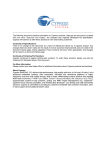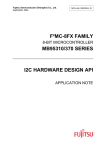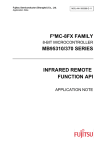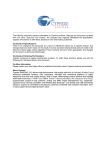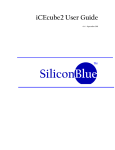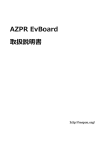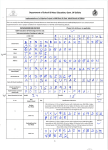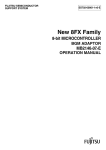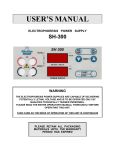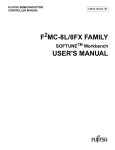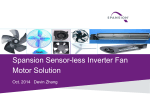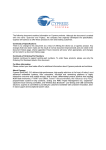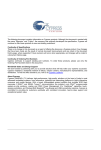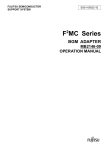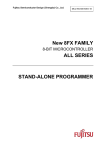Download 291KB - Spansion
Transcript
The following document contains information on Cypress products. Colophon The products described in this document are designed, developed and manufactured as contemplated for general use, including without limitation, ordinary industrial use, general office use, personal use, and household use, but are not designed, developed and manufactured as contemplated (1) for any use that includes fatal risks or dangers that, unless extremely high safety is secured, could have a serious effect to the public, and could lead directly to death, personal injury, severe physical damage or other loss (i.e., nuclear reaction control in nuclear facility, aircraft flight control, air traffic control, mass transport control, medical life support system, missile launch control in weapon system), or (2) for any use where chance of failure is intolerable (i.e., submersible repeater and artificial satellite). Please note that Spansion will not be liable to you and/or any third party for any claims or damages arising in connection with above-mentioned uses of the products. Any semiconductor devices have an inherent chance of failure. You must protect against injury, damage or loss from such failures by incorporating safety design measures into your facility and equipment such as redundancy, fire protection, and prevention of over-current levels and other abnormal operating conditions. If any products described in this document represent goods or technologies subject to certain restrictions on export under the Foreign Exchange and Foreign Trade Law of Japan, the US Export Administration Regulations or the applicable laws of any other country, the prior authorization by the respective government entity will be required for export of those products. Trademarks and Notice The contents of this document are subject to change without notice. This document may contain information on a Spansion product under development by Spansion. Spansion reserves the right to change or discontinue work on any product without notice. The information in this document is provided as is without warranty or guarantee of any kind as to its accuracy, completeness, operability, fitness for particular purpose, merchantability, non-infringement of third-party rights, or any other warranty, express, implied, or statutory. Spansion assumes no liability for any damages of any kind arising out of the use of the information in this document. ® ® ® TM Copyright © 2013 Spansion Inc. All rights reserved. Spansion , the Spansion logo, MirrorBit , MirrorBit Eclipse , TM ORNAND and combinations thereof, are trademarks and registered trademarks of Spansion LLC in the United States and other countries. Other names used are for informational purposes only and may be trademarks of their respective owners. Fujitsu Semiconductor (Shanghai) Co., Ltd. Application Note MCU-AN- 500052-E-10 F²MC-8FX FAMILY 8-BIT MICROCONTROLLER MB95310/370 SERIES I2C LIBRARY USAGE API APPLICATION NOTE I2C Library Usage API V1.0 Revision History Revision History Date 2009-11-10 2011-03-17 Author Jane Li Jane Li Change of Records V1.0, First draft Modify Chinese remark This manual contains 16 pages. 1. The products described in this manual and the specifications thereof may be changed without prior notice. To obtain up-to-date information and/or specifications, contact your Fujitsu sales representative or Fujitsu authorized dealer. 2. Fujitsu will not be liable for infringement of copyright, industrial property right, or other rights of a third party caused by the use of information or drawings described in this manual. 3. The contents of this manual may not be transferred or copied without the express permission of Fujitsu. 4. The products contained in this manual are not intended for use with equipments which require extremely high reliability such as aerospace equipments, undersea repeaters, nuclear control systems or medical equipments for life support. 5. Some of the products described in this manual may be strategic materials (or special technology) as defined by the Foreign Exchange and Foreign Trade Control Law. In such cases, the products or portions thereof must not be exported without permission as defined under the law. © 2009 Fujitsu Semiconductor (Shanghai) Co., Ltd MCU-AN- 500052-E-10 – Page 2 I2C Library Usage API V1.0 CONTENTS CONTENTS REVISION HISTORY .............................................................................................................. 2 CONTENTS ............................................................................................................................ 3 1 INTRODUCTION ................................................................................................................ 4 2 I2C LIBRARY FUNCTION LIST ........................................................................................ 5 3 I2C FUNCTION DETAIL .................................................................................................... 6 3.1 Initial_I2C Function ................................................................................................... 6 3.2 Write_I2C Function ................................................................................................... 7 3.3 Read_I2C Function ................................................................................................... 8 4 USAGE DEMO ................................................................................................................... 9 4.1 Usage Steps of MB95F310 MCU .............................................................................. 9 4.2 Software Usage Attention ....................................................................................... 12 4.3 Sequence of Data Transfer ..................................................................................... 12 5 DEBUGGING ................................................................................................................... 13 6 ADDITIONAL INFORMATION ......................................................................................... 15 7 APPENDIX ....................................................................................................................... 16 MCU-AN- 500052-E-10 – Page 3 I2C Library Usage API V1.0 Chapter 1 Introduction 1 Introduction This document introduces API for I2C library. Fujitsu MCU MB95F310 has I2C module and it can be used by connecting master device to slave device. In following chapter we will describe the library of Fujitsu MCU MB95F310. MCU-AN- 500052-E-10 – Page 4 I2C Library Usage API V1.0 Chapter 2 I2C Library Function List 2 I2C Library Function List This chapter introduces all functions in I2C library in project Simulate LCD EVBoard.prj which uses MB95F310 as MCU. Table 2-1 lists the I2C functions. Table 2-1: I2C Functions Function name Description void initial_I2C(void) Initializes I2C and sets shift clock frequency void Write_I2C(unsigned char addr, unsigned char subadd, unsigned char data) Writes data to slave chip unsigned char Read_I2C(unsigned char addr, unsigned char subaddr) Reads data from slave chip MCU-AN- 500052-E-10 – Page 5 I2C Library Usage API V1.0 Chapter 3 I2C Function Detail 3 I2C Function Detail This chapter introduces the detail of I2C functions. 3.1 Initial_I2C Function Table 3-1 describes initial_I2C function. Table 3-1: AD_Init Function Function name initial_I2C Function prototype void initial_I2C(void) Behavior description Initializes I2C and sets shift clock frequency Input parameter None Return value None Example Sets shift clock frequency to 23KHz when MCLK is 6MHz: initial_I2C(); This function is to initialize I2C. In this function default shift clock frequency is 23K when MCLK is 6MHz, and it can be decided by setting register ICCR. The shift clock frequency can be decided by following formula: FSCLK = MCLK / (m*n+2) The parameter m and n are decided by register ICCR0, which is used in initial function. User can ignore it when using 6M MCLK and 23 KHz shift clock frequency. MCU-AN- 500052-E-10 – Page 6 I2C Library Usage API V1.0 Chapter 3 I2C Function Detail 3.2 Write_I2C Function Table 3-4 describes Write_I2C function. Function prototype Table 3-2: Write_I2C Function void Write_I2C(unsigned char addr, unsigned char subadd, unsigned char data) Behavior description Writes data to slave chip Input parameter1 addr, address of slave chip, range is 0x00 to 0xff Input parameter2 subadd, sub address of slave chip, range is 0x00 to 0xff Input parameter3 data, data which write to slave chip, range is 0x00 to 0xff Return value None Example In case slave chip is EEPROM and it’s address is 0xa0, then write 0x25 to EEPROM sub-address 0x01: Write_I2C(0xa0,0x01,0x25); MCU-AN- 500052-E-10 – Page 7 I2C Library Usage API V1.0 Chapter 3 I2C Function Detail 3.3 Read_I2C Function Table 3-5 describes Read_I2C function. Function name Table 3-3: Read_I2C Function AD_Read Function prototype unsigned char Read_I2C(unsigned char addr, unsigned char subaddr) Behavior description Read data from slave chip Input parameter1 addr, address of slave chip, rang is 0x00 to 0xff Input parameter2 subadd, sub address of slave chip, rang is 0x00 to 0xff Return value Data saved in slave chip sub-address Example Read data from EEPROM and sub-address is 0x01: [variable]= Read_I2C(0xa0,0x01); MCU-AN- 500052-E-10 – Page 8 I2C Library Usage API V1.0 Chapter 4 Usage Demo 4 Usage Demo This chapter describes the steps of how to use this library and some usage cautions. 4.1 Usage Steps of MB95F310 MCU First step is adding I2C library to project document, Figure 4-1 is a sample for adding this library. Figure 4-1: First Step of Use I2C Library Second step is adding I2C library to project, Figure 4-2 is a sample for this work Figure 4-2: Second Step of Use I2C Library MCU-AN- 500052-E-10 – Page 9 I2C Library Usage API V1.0 Chapter 4 Usage Demo Third step is using the I2C library, for detailed library please refer to Table 2 – 1. About the initial function it is used in the library internally, so user can ignore it. If user wants to write data, please use Write_I2C function, Figure 4 – 3 is an example which writes data 0x25 to EEPROM sub-address 0x01. Figure 4-3: Example of Writing If user wants to read data from slave device, Figure 4 – 4 is an example which reads data from EEPROM sub-address 0x01. Figure 4-4: Example of Reading MCU-AN- 500052-E-10 – Page 10 I2C Library Usage API V1.0 Chapter 4 Usage Demo Fourth step is debugging, User needs to add debug document. Debugging mode includes serial interface, USB interface and LAN interface. Figure 4 – 5 is an example for creating serial interface debug document. Figure 4-5: Step of Setting Debug Environment For detailed debug information please refer to Chapter 5. MCU-AN- 500052-E-10 – Page 11 I2C Library Usage API V1.0 Chapter 4 Usage Demo 4.2 Software Usage Attention When writing data to slave device, if the slave device didn’t generate acknowledge sign to master, the following items may cause it: 4.3 ¾ The connect of I2C is not steady ¾ The power of slave chip maybe not normal ¾ I2C is not initialized, I2C bus is busy ¾ Shift frequency clock is not suitable for slave chip Sequence of Data Transfer When transmitting, the MSB bit is transmitted first. MCU-AN- 500052-E-10 – Page 12 I2C Library Usage API V1.0 Chapter 5 Debugging 5 Debugging This chapter describes how to debug the sample code I2C.prj on start kit and what will happen when the code is running. Attachment is the sample project I2C.prj. This project is based on our start-kit MB2146-450-E and the target MCU is MB95F310. For detailed information, you can access our website or contact with our sales window person. When debugging, user must connect slave device and master chip by I2C. Figure 5-1 describes the connecting. Figure 5-1: Hardware Description The value of pull up resister R25 and R26 can select from 1KΩ to 10kΩ. MCU-AN- 500052-E-10 – Page 13 I2C Library Usage API V1.0 Chapter 5 Debugging When debugging user can write or read data from EEPROM. In this project global variable Dat_Test is used to save the data read from slave device. Figure 5-2 is a debugging picture. User can see read result in watch window. Figure 5-2: See Variable Dat_Test MCU-AN- 500052-E-10 – Page 14 I2C Library Usage API V1.0 Chapter 6 Additional Information 6 Additional Information For more information about how to use MB95310 EV-board, BGM Adaptor and SOFTUNE, please refer to EV-Board MB2146-450-E User Manual, or visit websites: English version: http://www.fujitsu.com/cn/fsp/services/mcu/mb95/application_notes.html Simplified Chinese Version: http://www.fujitsu.com/cn/fss/services/mcu/mb95/application_notes.html MCU-AN- 500052-E-10 – Page 15 I2C Library Usage API V1.0 Chapter 7 Appendix 7 Appendix Table 2-1: I2C Functions .......................................................................................................... 5 Table 3-1: AD_Init Function ..................................................................................................... 6 Table 3-2: Describes Write_I2C Function ................................................................................ 7 Table 3-3: Read_I2C Function ................................................................................................. 8 Figure 4-1: First Step of Use I2C Library ................................................................................. 9 Figure 4-2: Second Step of Use I2C Library ............................................................................ 9 Figure 4-3: Example of Writing .............................................................................................. 10 Figure 4-4: Example of Reading ............................................................................................ 10 Figure 4-5: Step of Setting Debug Environment .................................................................... 11 Figure 5-1: Hardware Description .......................................................................................... 13 Figure 5-2: See Variable Dat_Test ........................................................................................ 14 MCU-AN- 500052-E-10 – Page 16



















